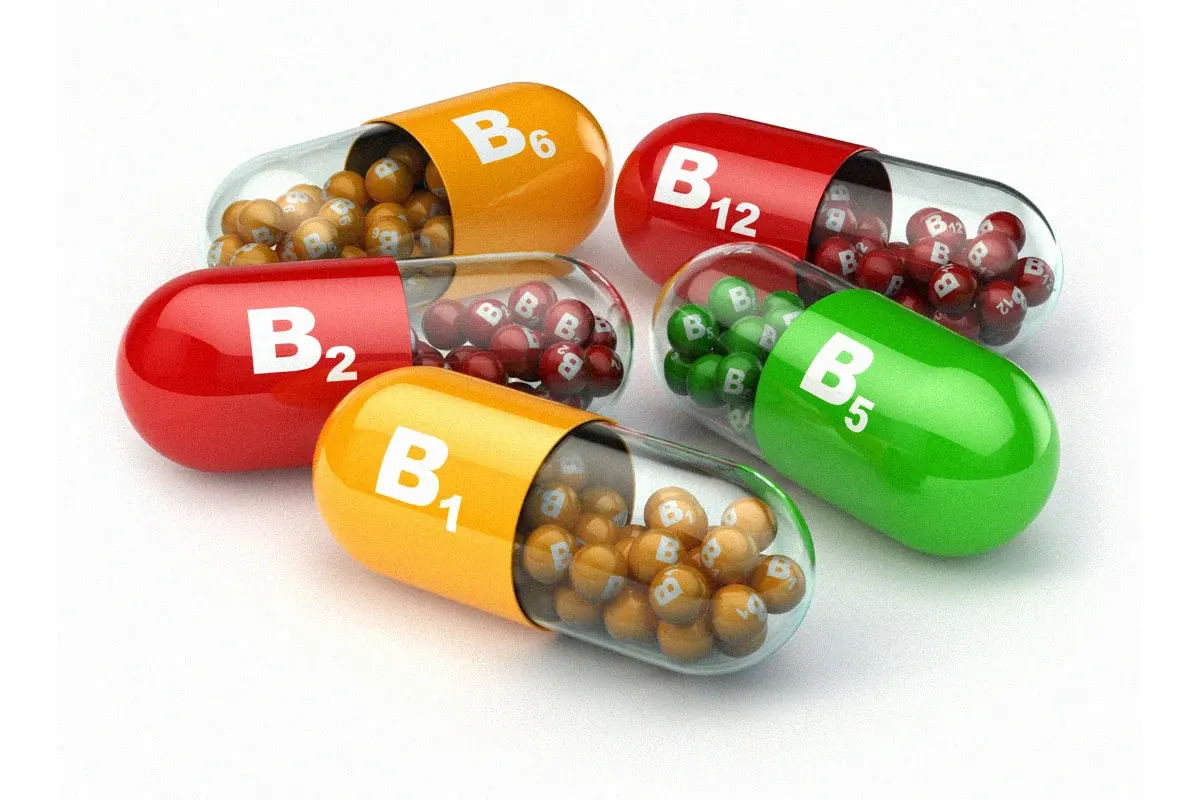Families are a complex collection of personalities with unique idiosyncrasies—each individual member is often so distinct that it’s hard to fathom how everyone can peacefully coexist. Luckily, a family’s shared origin can be enough to enable them to overlook any superficial differences and work together in a way that’s beneficial to the group at large.
B Complex of Vitamins
- Of the 13 essential vitamins, eight of them are B vitamins
- B vitamins are water soluble
- Utilized in many bodily capacities including energy, cellular protection, brain, and heart health
Vitamin B1 (Thiamine)
- Plays a fundamental role in metabolism
- It is particularly useful in energy production for your brain
Vitamin B2 (Riboflavin)
- In addition to boosting energy, riboflavin functions as an antioxidant
- One antioxidant produced by riboflavin is particularly helpful to vision health
Vitamin B3 (Niacin)
- Your body can produce niacin from tryptophan
- Niacin has been used to reduce cholesterol levels, and can also address skin conditions
Vitamin B5 (Pantothenic Acid)
- Nearly all foods contain at least some trace of vitamin B5
- Promotes a healthy physical response to stress
Vitamin B6 (Pyridoxine)
- A form of vitamin B6 that is involved in more than 150 of your body’s enzyme reactions
- Vitamin B6 lends a strong assist to cognitive health, while also contributing to the wellbeing of your skin and eyes
Vitamin B7 (Biotin)
- Biotin can benefit your skin and nails, guarding against brittle nails
- Women who are pregnant should consider adding biotin to their regimen
Vitamin B9 (Folate/Folic Acid)
- Folate has been linked to reproductive health for women
- Folate is also crucial to cognitive function and brain health
Vitamin B12 (Cobalamin)
- Vitamin B12 is vital for energy metabolism and the formation of red blood cells
- This vitamin works well with B6 and folic acid in brain health efforts
The B complex of vitamins weren’t born into a familial order, instead they were grouped together by scientists because of their common properties, how they function within your body, and where they are found in nature. But these vitamins share one crucial characteristic: they are incredibly important for your daily health. Indeed, of the 13 essential vitamins, eight of them are B vitamins.
While not technically an actual family, B vitamins do present family-like qualities. They support one another without question, while also maintaining the characteristics that mark them as complete individuals. The most obvious commonality in B vitamins is that they are water soluble, much like vitamin C. This is in stark contrast to fat-soluble vitamins like D, E, A, and K.
Water-soluble vitamins dissolve easily in water, meaning that they are readily absorbed into your body for immediate use in tissue. However, water soluble vitamins stored in your body, but instead are flushed out your system when you urinate—so they need to be replenished regularly through diet or supplementation.
With all eight B vitamins boasting both essential and water-soluble characteristics, the importance of their daily involvement in your overall health journey cannot be overstated. B vitamins each have their own array of talents that can be utilized across physiological functions including energy, vision, skin health, cellular protection and growth, metabolism, the digestive system, and brain health. And while plenty of foods have the potential to deliver the B vitamins you need, extended cooking and food processing can destroy or reduce the vitamin content.
But how is each individual member of the B complex of vitamins utilized by your body? And how do they unite as a family unit to make each other stronger? Let’s examine the health factors in this complex by the numbers.
Vitamin B1 (Thiamine)
The first compound to be called a vitamin, Thiamine has the distinction of being vitamin B1 and was the first in the complex discovered in the early 1900s, and later synthesized in the 1930s. Its earliest uses in Japan had it playing a major part in preventing and treating beriberi, a cardiovascular ailment that was rampant in the eastern hemisphere prior to 1900. Thiamine is found in whole grains, nuts, peas, and beans, along with lean pork, fish, poultry, eggs, and more.
Playing a fundamental role in metabolism, thiamine enables the body to transform carbohydrates into the energy we use on a daily basis. More specifically, your body needs thiamine to produce adenosine triphosphate (ATP), the molecule that transports the energy within your cells, especially key in the brain and nervous system.
Your brain is the most metabolically active organ in your entire body and as such, needs the most attention in terms of energy. This is where thiamine—and as we’ll discuss further, other B vitamins—are perhaps most essential. Thiamine metabolism in the brain is divided between your neurons and their neighboring glial cells, making vitamin B1 a pivotal player in the maintenance of brain function.
Vitamin B2 (Riboflavin)
The discovery of thiamine sparked a scientific quest to identify any accessory food factors that could potentially address ailments or generally help individuals achieve a healthier existence. In riboflavin, while researchers didn’t initially find a nutritional disease attributable to deficiency, it was the growth stimulation observed in animal studies that inspired further investigation and the eventual isolation of what would become vitamin B2. In addition to boosting energy, riboflavin functions as an antioxidant for the proper function of the immune system, and for healthy skin and hair. Natural sources of riboflavin include milk, eggs, nuts, broccoli, and meats.
Riboflavin gets deeply involved in cell growth and function by breaking down carbohydrates, proteins, and fats to produce energy, enabling the body to use the resulting oxygen. Riboflavin also gives a view of eye health, as an animal study by the University of Michigan revealed that the vitamin is needed to produce glutathione, a crucial eye antioxidant. Tying into that, the U.S. National Library of Medicine says that riboflavin could lower the risk of certain eye ailments like cataracts. Riboflavin also plays nice with the other members of the B complex, activating vitamins B1, B3, B6, and folate in your body.
Vitamin B3 (Niacin)
Niacin, third in the line of B vitamins, boasts a wide range of physiological purposes from the digestive system to your skin to the nervous system. And while niacin is found in the usual food sources for B vitamins—milk, eggs, meat, fish, and beans—your body can also make niacin from tryptophan, the amino acid we associate with sleepiness after a big, turkey-filled Thanksgiving meal.
In addition to its work breaking down carbohydrates and producing energy, niacin has been used to reduce cholesterol levels, potentially reducing the risk of heart disease. Meanwhile, another chemical form of niacin could help address certain skin conditions when combined with other elements.
Vitamin B5 (Pantothenic Acid)
The scientific name of vitamin B5, pantothenic, translates from the Greek “from everywhere,” which tells you everything you need to know about where this particular vitamin can be found; nearly all foods contain at least a small quantity of pantothenic acid. Along with the common B-vitamin traits of metabolizing food into energy, pantothenic acid also helps your body produce red blood cells and steroid hormones.
Another potential benefits of vitamin B5 is its purported usefulness in helping to lower cholesterol. In a 2011 study, subjects were given a derivative of the vitamin and the results showed a favorable reduction in lipoprotein cholesterol. But perhaps one of the most intriguing aspects of pantothenic acid is in the development of stress-related hormones in the adrenal glands. Along with vitamins B1 and B6, the coenzyme form of B5 (and B12) could help individuals sustain healthy responses to stress, thereby minimizing negative physical effects.
Vitamin B6 (Pyridoxine)
Representing three similar, yet different compounds, vitamin B6 gets involved in an astonishing number of reactions in your body that assist cells in normal, everyday functions. In fact, one form of vitamin B6, known as pyridoxal 5'-phosphate (PLP), is involved in more than 150 of your body’s enzymatic reactions. This extremely active form of vitamin B6 has been known to be in short supply when various types of inflammation are at their worst.
But vitamin B6 is perhaps best known for its association with cognitive function and overall brain health. One study in particular showed that high levels of the vitamin (along with folate and vitamin B12) slowed age-related shrinkage in certain areas of the brain associated with cognitive decline. What’s more, your body needs vitamin B6 to produce neurotransmitters like dopamine and serotonin, both of which have been linked to depression.
Your skin and eyes can also reap the benefits of vitamin B6. A seven-year study showed that vitamin B6 combined with folate and vitamin B12 reduced the risk of age-related eye conditions by about 40 percent.
Vitamin B7 (Biotin)
Known at different times as coenzyme R and vitamin H (the H represents haar and haut, German for hair and skin), biotin eventually found itself classified as vitamin B7. But the Germans were certainly on the right track, as this particular compound, while important to metabolic pathways like the production of glucose and fatty acids, boasts benefits for all things hair and skin, including brittle, thin nails.
In one study, 67 percent of subjects given a steady supplementation of biotin demonstrated a 25 percent increase in overall nail thickness. A similar study netted comparable results, with all participants showing noticeable strengthening of their brittle nails. And while the evidence of biotin’s prowess in increasing hair growth in healthy individuals is hard to come by, there is evidence that a deficiency of the vitamin could lead to hair loss.
But perhaps what is most interesting about biotin is its importance during pregnancy and breastfeeding. Research shows that during pregnancy and lactation, women could develop a slight biotin deficiency—which could be caused by the body breaking down biotin more quickly during pregnancy.[35][36][37]
Vitamin B9 (Folate/Folic Acid)
First, let’s get the obvious question out of the way: What is the difference between folate and folic acid? Simply put, folic acid is the synthetic form of folate—so if it occurs naturally in foods it’s folate, but if it’s added to foods in a lab, you’ve got folic acid. But expect to just ingest folic acid and have it go to work, as this synthetic compound must be converted into active vitamin B9 through an enzyme-enabled process.
Whether converted from its synthetic form or absorbed from natural sources, folate has been linked to various health benefits, including pregnancy-related advantages much like biotin. In fact, researchers recommend that all women who are at reproductive age should increase their daily intake of folate.
Folate/folic acid is also crucial to people of all ages for mood support and cognitive function. Research shows that in lab tests folic acid could lower inflammation and your levels of homocysteine, the pesky amino acid that potentially contributes to a decline in brain health. Going deeper into the inner workings of the brain, studies demonstrate that folic acid could switch off the genes that set negative brain conditions in motion as you age.
Folate also lends a hand in the production of red blood cells—as does the next, and last B vitamin on our list.
Vitamin B12 (Cobalamin)
And finally, there’s vitamin B12—which has been so important in the history of human health, that it has been the subject of two separate Nobel Prizes. In relation to energy and fending off fatigue and weakness, vitamin B12 plays a vital role in the formation of the red blood cells that transport oxygen to your organs.
Meanwhile, vitamin B12 is a great example of a B vitamin that works with other members of the complex in astounding ways to make you healthier. Studies show that B12 hooks up with B6 and folic acid to strengthen your brain and guard against cognitive decline. An Oxford University study demonstrated that these three B vitamins in tandem could potentially reduce brain atrophy while improving cognitive function.
But it doesn’t stop at the blood and the brain. Vitamin B12 could also support bone health, prevent age-related eye conditions, and provide an energy boost if your B12 levels are especially low.
Add It Up
The array of vitamins in the B complex goes even deeper than the above list, with an interesting collection of compounds that fill in the gaps between B vitamins—vitamin B4 for example, which is not considered a part of the family. However, in examining the vitamins that do take a bow on the above list, it becomes clear that B vitamins are all about energy—but instead of merely referring to the energy that gets you out of bed in the morning, it’s the energy your body needs to support healthy physiological processes from the top of your head to the tips of your toes.









